Inhibition of the PI3K/AKT pathway potentiates cytotoxicity of EGFR kinase inhibitors in triple-negative breast cancer cells
- PMID: 23601074
- PMCID: PMC3822817
- DOI: 10.1111/jcmm.12046
Inhibition of the PI3K/AKT pathway potentiates cytotoxicity of EGFR kinase inhibitors in triple-negative breast cancer cells
Abstract
Triple-negative breast cancers (TNBCs) are known to be intrinsically resistant to inhibitors for epidermal growth factor receptor (EGFR). Until now, clinical trials for TNBCs using EGFR inhibitors (EGFRis) as single agents have yielded disappointing results. Here, we report that combinatorial treatment using EGFRis, such as gefitinib or erlotinib, with PI3K/AKT pathway inhibitors (PI3K/AKTis) demonstrated a synergistic, anti-proliferative effect in cell lines of the basal-like (BL) subtype, a subtype of TNBC. Western blot analysis revealed that the gefitinib/PI-103 combination significantly reduced the level of both phospho-AKT and phospho-ERK in two susceptible BL subtype cell lines, SUM149PT and MDA-MB-468, whereas it had little or no effect on the level of phospho-ERK in two non-susceptible cell lines (HS578T and MDA-MB-231) of mesenchymal stem-like (MSL) TNBC subtype. The gefitinib/PI-103 combination also significantly induced caspase-3/7-mediated PARP cleavage and reduced two anti-apoptotic proteins, XIAP and Bcl-2 in the susceptible cell lines. In addition, the level of myeloid cell leukemia 1 (Mcl-1) protein was markedly decreased by gefitinib/PI-103 combination in the BL TNBC cells, but showed no significant change by this combination in MSL subtype cells. These results suggest that pharmacological inhibition of EGFR used in combination of PI3K/AKTis is a potential therapeutic approach to treat a subtype of TNBCs.
© 2013 The Authors. Published by Foundation for Cellular and Molecular Medicine/Blackwell Publishing Ltd.
Figures





Similar articles
-
Inhibition of RPTOR overcomes resistance to EGFR inhibition in triple-negative breast cancer cells.Int J Oncol. 2018 Mar;52(3):828-840. doi: 10.3892/ijo.2018.4244. Epub 2018 Jan 15. Int J Oncol. 2018. PMID: 29344641
-
Epidermal growth factor receptor as a potential therapeutic target in triple-negative breast cancer.Ann Oncol. 2009 May;20(5):862-7. doi: 10.1093/annonc/mdn710. Epub 2009 Jan 15. Ann Oncol. 2009. PMID: 19150933
-
Transient PI3K inhibition induces apoptosis and overcomes HGF-mediated resistance to EGFR-TKIs in EGFR mutant lung cancer.Clin Cancer Res. 2011 Apr 15;17(8):2260-9. doi: 10.1158/1078-0432.CCR-10-1993. Epub 2011 Jan 10. Clin Cancer Res. 2011. PMID: 21220474
-
Drugging the PI3 kinome: from chemical tools to drugs in the clinic.Cancer Res. 2010 Mar 15;70(6):2146-57. doi: 10.1158/0008-5472.CAN-09-4355. Epub 2010 Feb 23. Cancer Res. 2010. PMID: 20179189 Free PMC article. Review.
-
Genetically engineered mouse models of PI3K signaling in breast cancer.Mol Oncol. 2013 Apr;7(2):146-64. doi: 10.1016/j.molonc.2013.02.003. Epub 2013 Feb 11. Mol Oncol. 2013. PMID: 23478237 Free PMC article. Review.
Cited by
-
Expression of caveolin-1 is correlated with lung adenocarcinoma proliferation, migration, and invasion.Med Oncol. 2015 Jul;32(7):207. doi: 10.1007/s12032-015-0644-5. Epub 2015 Jun 21. Med Oncol. 2015. PMID: 26094077
-
Chloroquine sensitizes MDA-MB-231 cells to osimertinib through autophagy-apoptosis crosstalk pathway.Breast Cancer (Dove Med Press). 2019 Jul 23;11:231-241. doi: 10.2147/BCTT.S211030. eCollection 2019. Breast Cancer (Dove Med Press). 2019. PMID: 31839713 Free PMC article.
-
Ad-p53 enhances the sensitivity of triple-negative breast cancer MDA-MB-468 cells to the EGFR inhibitor gefitinib.Oncol Rep. 2015 Feb;33(2):526-32. doi: 10.3892/or.2014.3665. Epub 2014 Dec 11. Oncol Rep. 2015. PMID: 25501339 Free PMC article.
-
Potential therapeutic targets of triple-negative breast cancer based on its intrinsic subtype.Oncotarget. 2017 Aug 16;8(42):73329-73344. doi: 10.18632/oncotarget.20274. eCollection 2017 Sep 22. Oncotarget. 2017. PMID: 29069872 Free PMC article. Review.
-
A Phase I Dose-Escalation Study of the Safety and Pharmacokinetics of Pictilisib in Combination with Erlotinib in Patients with Advanced Solid Tumors.Oncologist. 2017 Dec;22(12):1491-1499. doi: 10.1634/theoncologist.2017-0090. Epub 2017 Aug 10. Oncologist. 2017. PMID: 28798270 Free PMC article. Clinical Trial.
References
-
- Alvarez RH, Valero V, Hortobagyi GN. Emerging targeted therapies for breast cancer. J Clin Oncol. 2010;28:3366–79. - PubMed
-
- Normanno N, Morabito A, De Luca A, et al. Target-based therapies in breast cancer: current status and future perspectives. Endocr Rel Cancer. 2009;16:675–702. - PubMed
-
- Bianchini G, Iwamoto T, Qi Y, et al. Prognostic and therapeutic implication of distinct kinase expression patterns in different subtypes of breast cancer. Cancer Res. 2010;70:8852–62. - PubMed
Publication types
MeSH terms
Substances
LinkOut - more resources
Full Text Sources
Other Literature Sources
Medical
Research Materials
Miscellaneous

